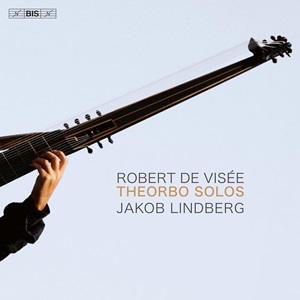
Robert de Visée (c.1655-1733)
Theorbo Solos
Jakob Lindberg (theorbo)
rec. 2023, Länna Church, Norrtälje, Sweden
BIS SACD 2562 [78]
Robert de Visée was the Sun King’s favourite, perhaps surprisingly, because he was born in Portugal and started as a choirboy in Coimbra. Mind you, the King’s other favourite, Jean-Baptiste Lully, was born in Italy. The court of Louis XIV was clearly international, at least in intention.
Most of the music here is to be found in a manuscript of 137 pieces, compiled by a nobleman, Jean-Étienne Vaudry de Saizenay. Visée himself published two books of lute solos in 1682 and 1686. He dedicated them to the King, who it seems would ask the composer to play whilst he was in bed; they even played duets! It is more significant for our purposes that in 1716 Visée published the collection Pièces de theorbo et de luth mises en partition, dessus et basse.
Jakob Lindberg offers us three Suites of dances such as Allemande, Courante and Gigue, and twelve other pieces organised by key. The last track is a brief Folies d’Espagne, a set of variants of a well-known chord progression. A full appreciation of the Suites requires careful listening to much complex ornamentation, through which one discovers the contour of the melodic line and the supporting harmonies.
The twelve Pieces in three collections are in a slightly more relaxed style. The D minor set has two interesting transcriptions: an arrangement of Lully’s brief dance Entrée d’Apollon from Le Triomphe de l’Amour, and Purcell’s Contredance. There is also a transcription of Couperin’s Les Sylvanus, and Lully’s Entrée des Espagnolles from the famous Le Bourgeois Gentilhomme in the G major set. Especially moving among the C minor pieces is Tombeau de Mesdemoiselles de Visée, remembering the tragic early deaths of Visée’s two young daughters.
Lindberg devotes part of his fascinating booklet notes to the kind of theorbo Visée would have played, and to the one he plays. Michael Lowe made an instrument for him in 1979 based on a 17th-century model. The construction and tuning are a bit over my head, but let me note that the bass lines are very resonant, even dominant, unlike how lutes sound. Visée’s instrument needed a strong harmonic basis, because it featured in the court orchestra and was played in operas. The inside of the cardboard cover has a photograph of Lindberg’s theorbo.
This disc is so pleasant because a beautiful instrument is beautifully played and beautifully recorded. Also, the music is mostly elegant and civilised. The programme is clearly constructed, and it is a great joy to hear how effortlessly Lindberg negotiates the ornamentation and elucidates the melody.
Gary Higginson
Buying this recording via a link below generates revenue for MWI and helps us keep free access to the site



Contents
1-7. Suite in A minor
8-12. Suite in D major
13-17. Pieces in D minor
18-19. Pieces in C minor
20-24. Pieces in G major
25-31. Suite in E minor
32. Folies d’Espagne

















